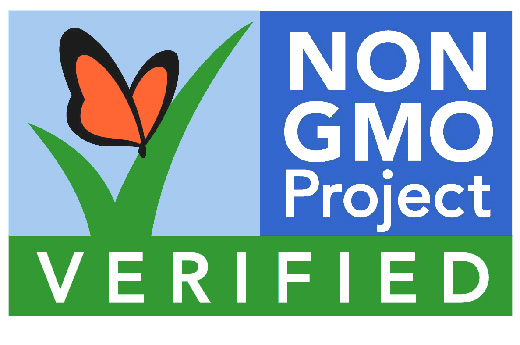by guest blogger Courtney Pineau, communications manager for the Non-GMO Project
In our household, spring-cleaning is often inspired by those first days of springtime sun when I discover the cobwebs and dust bunnies that have been hiding in the shadows all winter. It’s amazing what a little light can expose. Spring-cleaning our diets can happen the same way: When you look a little closer, you often find that your food contains ingredients with unwanted genetically modified organisms (GMOs). I hope these spring-cleaning tips help you find new ways to nourish your family with healthy non-GMO foods.
GMOs are plants or animals created through the gene-splicing techniques of biotechnology. These are organisms that would never occur naturally in nature. There are many risks associated with GMOs, but I keep them out of my home because I have no interest in feeding my family experimental foods. I feel very unsettled about the studies showing potential long-term health consequences from the consumption of GMOs—there is so much that we don’t know about these engineered “foods.” I also believe that one of the most powerful things I can do as a consumer is to vote with my wallet. Why would I purchase food that is unhealthy for my family and the environment?
If you are ready to spring-clean GMOs out of your diet, here are 10 easy steps to help you give them the boot:
1. Kick out the high-GMO-risk breakfast cereal. If your breakfast cereal contains corn, soy, or canola (as most do), it likely contains GMOs. Starting this spring, make sure that the cereal you choosed is Non-GMO Project Verified. The Non-GMO Project has a fantastic selection of verified breakfast foods.
2. Use canola oil wisely. Approximately 90 percent of the canola in the United States is GMO, so if you choose to use canola oil, make sure from here on that you buy a Non-GMO Project Verified brand. If you can’t find a verified canola oil in your local store, you can also switch high-risk canola for a low-risk alternative like olive oil (for low-temperature cooking) and unrefined coconut oil (for high-temperature cooking).
3. Remember that “natural” doesn’t always mean what you think it does. “Natural” products are just as likely to be GMO as conventional ones. Even natural products purchased at the health food store may contain GMOs. Need help finding verified products when you are shopping? Download the Non-GMO Project iPhone app from the Apple store.
4. Pack a non-GMO lunchbox. Keep your family members eating non-GMO when they are at school and work by packing them a non-GMO lunch. Many lunch items like granola bars, lunchmeats, and snack packs contain ingredients that are most likely GMO. Corn, soy, and canola are everywhere! Luckily, there are many great Non-GMO Project Verified lunch foods. Trying changing one lunch item at a time to help your family transition to food that is non-GMO. Great places to start: snack foods, breads and crackers, frozen meals, and treats.
5. Give your soy products an overhaul. Soy is present in a huge number of processed foods, from the obvious in foods like soy milk, tofu, and soy sauce, to hidden sources that include almost all packaged snack bars, meats, breads, and such. Soy is everywhere! Since more than 94 percent of soy in the United States is GMO, it’s important to make sure your soy products are Non-GMO Project Verified whenever possible.
6. Be skeptical of corn products. Our family loves Mexican food, however, since 88 percent of U.S. corn is now genetically engineered, we’ve had to look for non-GMO alternatives to our favorite products. Thankfully, there are many delicious verified chip and tortilla (search “tortillas” on the Non-GMO project website) brands. Like soy, corn shows up where you least expect it. Be a label sleuth!
7. Look for hidden GMO ingredients. GMOs may be hidden in common processed food ingredients, such as: amino acids, aspartame, ascorbic acid, sodium ascorbate, vitamin C, citric acid, sodium citrate, flavorings (“natural” and “artificial”), high-fructose corn syrup, hydrolyzed vegetable protein, lactic acid, maltodextrins, molasses, monosodium glutamate, sucrose, textured vegetable protein (TVP), xanthan Gum, vitamins, yeast products.
8. Satisfy your sweet tooth with non-GMO treats. In our culture, it is not uncommon to celebrate or show our appreciation with treats. Unfortunately, many candies and other packaged sweets are full of beet sugar, soy, and corn—all very-high-GMO-risk ingredients. Make sure you are treating your family with non-GMO goodies!
9. Be proactive. If there is a product listed on our website that is not carried at your local grocery store, ask your local retailer to see if the store can stock it. Most retailers are happy to try and fulfill customer requests. If there is a brand that you would like to see become Non-GMO Project Verified, make a product verification request.
10. Become a GMO-risk-reduction ninja! First, learn what crops are GMO—thankfully, the list is short. Second, make a list of the foods your family eats most often. Next, find a Non-GMO Project Verified alternative. If you can’t find one, look for a certified-organic option. If all else fails, looks for a low-risk alternative to a high-GMO-risk product.
 Courtney Pineau spends her days working as the communications manager for the Non-GMO Project. The work perfectly integrates her lifelong passion for all things related to the soil (cooking good food, organic gardening, and just getting dirty) and her love for educating others about their collective power to create a healthier food system. To learn more about the work of the Non-GMO Project, please visit nongmoproject.org.
Courtney Pineau spends her days working as the communications manager for the Non-GMO Project. The work perfectly integrates her lifelong passion for all things related to the soil (cooking good food, organic gardening, and just getting dirty) and her love for educating others about their collective power to create a healthier food system. To learn more about the work of the Non-GMO Project, please visit nongmoproject.org.





I would like to know about Trader Joes. They say they are non-GMO but they do not allow independent groups verify. Can we trust the company?
Stay away from corn, Stay away from corn, Stay away from corn!
The article doesn’t say anything about going organic. I was under the impression if the soy/corn/wheat/whatever it is is organic, then it’s also automatically non-GMO. So the non GMO project is irrelevant if you’re buying 100% organic, right?
In order to truly live organic we need the tools and resources to point us in the right direction. We can’t expect the USDA or corporations to teach us, it’s not in their “financial” best interest.
If something is labeled USDA 100% certified organic, it does not contain GMO materials. Coconut oil is a great alternative to canola and corn oil, especially for baking and cooking.
NonGMO isn’t truly NonGMO unless the seeds are NonGMO.
How do we know the seeds are NonGMO?
Growing without chemical fertilizer while using GMO seeds still is GMO.